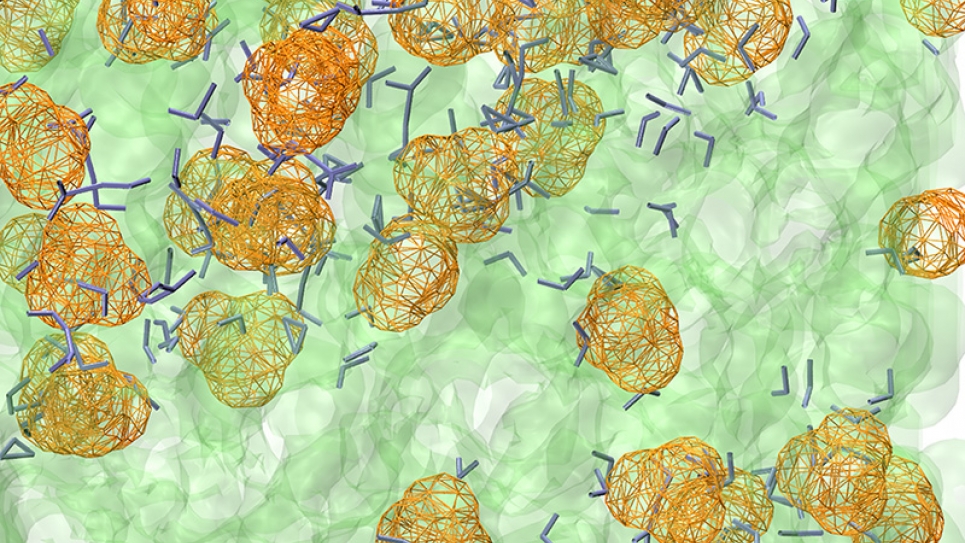
ALCC program awards 1.64 billion hours of supercomputing time at ALCF
The U.S. Department of Energy’s Advanced Scientific Computing Research (ASCR) program has awarded 19 projects a total of 1.64 billion core-hours at the Argonne Leadership Computing Facility (ALCF) to pursue challenging, high-reward simulation research.
Each year ASCR, which funds and manages three of the nation’s most powerful supercomputing facilities for simulation science, sets aside 30% of the available computing time on these systems for projects that further DOE mission science through its ASCR Leadership Computing Challenge (ALCC).
ALCC grants one-year awards that range from a few million to several-hundred-million processor hours on ASCR’s two Leadership Computing Facility centers at Argonne National Laboratory and Oak Ridge National Laboratories, and at NERSC at Lawrence Berkeley National Laboratory. For 2014, 42 ALCC awards were given totaling 3.1 billion processor hours.
ALCC projects apply the leading mathematical and computer science techniques to a set of challenges in areas of special interest to the DOE, such as advancing clean energy, advancing predictive understanding of climate and environmental systems, and responding to natural and man-made disasters. ALCC also serves to expand the community of researchers capable of using leadership computing resources.
Following is a summary of the 19 projects awarded time at the ALCF. Some projects received additional allocations at Oak Ridge National Laboratory and/or NERSC.
- Brian Wirth, University of Tennessee, was awarded 66 million core-hours to conduct simulations to better understand fusion power plant materials and operating conditions by studying the response of tungsten, the proposed ITER divertor, to low-energy helium plasma exposure.
- Robert DiStasio Jr., Princeton University, received 350 million core-hours to perform ab initio molecular dynamics simulations to investigate the structure of water in a series of dilute aqueous ionic solutions, at a catalytic metal-oxide interface, and in extreme aqueous environments.
- Noa Marom, Tulane University, received 75 million core-hours to conduct large-scale simulations of functional interfaces in organic photovoltaics and dye-sensitized solar cells to help derive design rules that will improve the efficiency of these solar energy technologies.
- Parviz Moin, Stanford University, was awarded 120 million core-hours to address key aspects of large eddy simulations (LES) of realistic, complex engineering flows. The work aims to demonstrate LES as a potential tool for industry to design more energy efficient aircrafts on future exascale systems.
- Hassan Nagib, Illinois Institute of Technology/KTH Mechanics, received 11 million core-hours to perform a numerical study aimed at providing a deeper fundamental understanding of wall-bounded turbulence.
- Igor Bolotnov, North Carolina State University, received 76.8 million core-hours to carry out simulations of turbulent bubbly two-phase flows to better understand thermal-hydraulics phenomena critical for nuclear reactor safety analysis.
- Sanjiva Lele, Stanford University, was awarded 36.5 million core-hours to perform large eddy simulations to study the flow physics that cause wind turbines to produce intense amplitude-modulated noise under adverse conditions.
- Christopher Holland, University of California, San Diego, received 90 million core-hours to investigate whether multiscale gyrokinetic simulations are better suited to reproduce nuclear fusion experimental measurements than conventional ion-only simulations.
- Ron Brightwell, Sandia National Laboratories, was awarded 5 million core-hours to develop an operating system and runtime system environment that provides a research foundation for extreme-scale scientific computing.
- Elia Merzari, Argonne National Laboratory, was awarded 80 million core-hours for continued support of DOE’s Center for Exascale Simulation for Advanced Reactors (CESAR) with large-scale simulations that will address the limitations of current nuclear reactor core simulation tools and potential scaling issues for larger machines.
- Giancarlo Trimarchi, Northwestern University, received 30 million core-hours to advance the design of novel energy materials by developing and applying a new generation of structure prediction methods that transcend current approaches and scale to larger crystal structures.
- Peter Thornton, Oak Ridge National Laboratory, received 107 million core-hours to develop DOE’s next-generation Earth systems model to help researchers answer several pressing climate prediction questions.
- Thomas LeCompte, Argonne National Laboratory, was awarded 50 million core-hours to generate simulated collision events to help the ATLAS experiment at CERN’s Large Hadron Collider.
- Julius Kuti, University of California, San Diego, received 88.7 million core-hours to provide credible testing of new physics from the composite Higgs theory, which resulted from the recent discovery of the Higgs particle.
- Salman Habib, Argonne National Laboratory, was awarded 100 million core-hours to develop a computational end-station to bring together large-scale simulation activities in the cosmic microwave background, cosmic reionization, and large-scale structure as probed by spectroscopic and imaging surveys.
- David Baker, University of Washington, received 200 million core-hours to advance a multistate enzyme design strategy to create designer enzymes with a broad range of medical, environmental, and energy applications.
- Aidan Thompson, Sandia National Laboratories, was awarded 80 million core-hours to study chemical reactivity and detonation in energetic materials, with the goal of enabling predictive models of the performance, reliability, and failure of such materials.
- Gregory Voth, University of Chicago, received 57.6 million core-hours to shed light on the fundamental mechanisms governing charge transport processes in fuel cells.
- Martin Berzins, University of Utah, received 10 million core-hours to investigate the design space required to develop more efficient oxy-coal boiler technologies for clean electric energy.